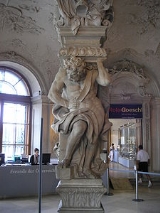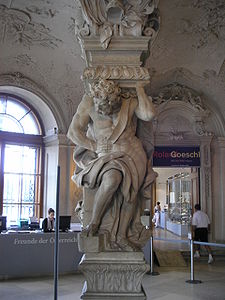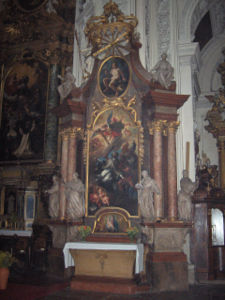
Lorenzo Mattielli
Encyclopedia
Lorenzo Mattielli was an Italian sculptor from the Late Baroque
period. His name has also variously been written as Matielli, Mattiely, Matthielli, and Mathielli. He supplied statuary for palaces and churches in Vienna and Dresden and for the monastery of Melk
(Austria).

, Italy, but the exact date remains unknown. Different sources give different dates : 1678 to 1688. He apprenticed in the workshop of the famous Vicenzan sculptors Orazio
(1643–1720) and his younger brother, Angelo Marinali. IN 1705, he married Angelo’s daughter and joined of the sculptors’ guild of Vicenza. He worked, together with the brothers Marinali, on the decoration of the Villa Conti (now Lampertico) in Vicenza
He remarried soon after he settled in Vienna
in 1712, suggesting he must have been widowed while in Italy, and his wife died at a young age. His new wife, Elisabeth Saceoni, also died very young in 1717, after bearing four children. In 1723, he married for the third time, to Maria Magdalena Kronawatter, and with her fathered seven children. The oldest son, Francesco Antonio Mattielli, would later join Lorenzo's workshop in Vienna.
Among his first commissions in Vienna were the statues for the new Palace (designed by Antonio Beduzzi
) and the garden of the rich merchant Leopold von Engelskirchner. Most were destroyed in World War II, but four Attica statues remain (three in the Hofburg in Innsbruck
and one in the “Historischen Museum” in Vienna
).
Lorenzo Mattielli soon became a close friend of Antonio Beduzzi
, who had quickly recognized his skills. They worked often together on the same projects, Beduzzi as painter and designer and Mattielli as sculptor. In the same way, he also worked together with the architect Joseph Emanuel Fischer von Erlach
(Karlskirche
, Imperial stables in the Hofburg, Schwarzenberg Palace, Reichkanzlertrakt in the Hofburg, Harrach Palace
).
In 1714, on Beduzzi's recommendation, Mattielli was appointed sculptor-in-chief at the imperial court of Charles VI
. This prestigious appointment garnered him many further commissions from the court, upper aristocracy and churches, such as by Prince Adam Franz von Schwarzenberg, Prince Anton Florian von Liechtenstein, and the family of Count Harrach. He became so inundated with orders that he worked simultaneously on different projects in Vienna, Stift Melk, Lambach Abbey
and Mariazell
. Therefore he could only have produced the designs for these sculptures, leaving the actual manual sculpting to local craftsmen. The routine jobs were performed by his workshop.
In these first ten years in Vienna, he slowly developed a personal style with a refined elegance, especially after his trip to Italy (1720–1722).
In 1738, Lorenzo Mattielli was invited to Dresden
by king August III, who was married to Maria Josepha
, daughter of emperor Joseph I
and a long-time Maecenas of Mattielli. He was appointed chief sculptor to the court, receiving special privileges and an adequate remuneration. In 1744 he was appointed inspector in charge of antique and modern statues.
 Between 1741 and 1746 he worked at the Neptune fountain in the garden of the Palais Brühl-Marcolini in Friedrichstadt (Dresden)
Between 1741 and 1746 he worked at the Neptune fountain in the garden of the Palais Brühl-Marcolini in Friedrichstadt (Dresden)
. This has become one of his major works.
As the king was building the Hofkirche, a Catholic church in Dresden
designed by the Roman Gaetano Chiavari, he commissioned Mattielli to provide 78 statues for this church. These large, sandstone statues stand on a balustrade, surrounding the church. They depict 74 saints and four allegorical figures : Belief, Hope, Charity and Justice. After his death in 1748, his son Francesco finished the work of his father with the statues at the tower in 1752. Many statues were completely destroyed during the bombardment of Dresden on 13 February 1945. Their restoration and the new statues were finished in 2002.
Lorenzo Mattielli was buried in the churchyard of the Hofkirche in Dresden, the city in which he died.
Vienna :
Melk Abbey
Klosterneuburg
Warsaw
Baroque
The Baroque is a period and the style that used exaggerated motion and clear, easily interpreted detail to produce drama, tension, exuberance, and grandeur in sculpture, painting, literature, dance, and music...
period. His name has also variously been written as Matielli, Mattiely, Matthielli, and Mathielli. He supplied statuary for palaces and churches in Vienna and Dresden and for the monastery of Melk
Melk Abbey
Melk Abbey or Stift Melk is an Austrian Benedictine abbey, and one of the world's most famous monastic sites. It is located above the town of Melk on a rocky outcrop overlooking the river Danube in Lower Austria, adjoining the Wachau valley....
(Austria).

Biography
He was born in VicenzaVicenza
Vicenza , a city in north-eastern Italy, is the capital of the eponymous province in the Veneto region, at the northern base of the Monte Berico, straddling the Bacchiglione...
, Italy, but the exact date remains unknown. Different sources give different dates : 1678 to 1688. He apprenticed in the workshop of the famous Vicenzan sculptors Orazio
Orazio Marinali
Orazio Marinali was an Italian late-baroque sculptor, active mainly in the Veneto or Venetian mainland.He trained with Josse de Corte. He is best known for over 150 statues produced by him and his studio for the estate and gardens of a single villa in Vicenza, the Villa Lampertico...
(1643–1720) and his younger brother, Angelo Marinali. IN 1705, he married Angelo’s daughter and joined of the sculptors’ guild of Vicenza. He worked, together with the brothers Marinali, on the decoration of the Villa Conti (now Lampertico) in Vicenza
He remarried soon after he settled in Vienna
Vienna
Vienna is the capital and largest city of the Republic of Austria and one of the nine states of Austria. Vienna is Austria's primary city, with a population of about 1.723 million , and is by far the largest city in Austria, as well as its cultural, economic, and political centre...
in 1712, suggesting he must have been widowed while in Italy, and his wife died at a young age. His new wife, Elisabeth Saceoni, also died very young in 1717, after bearing four children. In 1723, he married for the third time, to Maria Magdalena Kronawatter, and with her fathered seven children. The oldest son, Francesco Antonio Mattielli, would later join Lorenzo's workshop in Vienna.
Among his first commissions in Vienna were the statues for the new Palace (designed by Antonio Beduzzi
Antonio Beduzzi
Antonio Maria Nicolao Beduzzi was an Austrian-Italian theater engineer, painter, and architect who flourished in Vienna at the turn of the 17th century....
) and the garden of the rich merchant Leopold von Engelskirchner. Most were destroyed in World War II, but four Attica statues remain (three in the Hofburg in Innsbruck
Innsbruck
- Main sights :- Buildings :*Golden Roof*Kaiserliche Hofburg *Hofkirche with the cenotaph of Maximilian I, Holy Roman Emperor*Altes Landhaus...
and one in the “Historischen Museum” in Vienna
Kunsthistorisches Museum
The Kunsthistorisches Museum is an art museum in Vienna, Austria. Housed in its festive palatial building on Ringstraße, it is crowned with an octagonal dome...
).
Lorenzo Mattielli soon became a close friend of Antonio Beduzzi
Antonio Beduzzi
Antonio Maria Nicolao Beduzzi was an Austrian-Italian theater engineer, painter, and architect who flourished in Vienna at the turn of the 17th century....
, who had quickly recognized his skills. They worked often together on the same projects, Beduzzi as painter and designer and Mattielli as sculptor. In the same way, he also worked together with the architect Joseph Emanuel Fischer von Erlach
Joseph Emanuel Fischer von Erlach
Joseph Emanuel Fischer von Erlach, also Fischer von Erlach the younger was an Austrianarchitect of the baroque, Rococo and baroque classicism.-Life and career:...
(Karlskirche
Karlskirche
The St. Charles's Church is a church situated on the south side of Karlsplatz, Vienna. It is located on the edge of the 1st district, 200 metres outside the Ringstraße...
, Imperial stables in the Hofburg, Schwarzenberg Palace, Reichkanzlertrakt in the Hofburg, Harrach Palace
Palais Harrach
Palais Harrach is a Baroque palace in Vienna, Austria. It was owned by the noble Harrach family. It was extensively renovated and restored in the late 1990s and houses offices and shops today.-History:From 1600 to 1658, it was property of Freyung family...
).
In 1714, on Beduzzi's recommendation, Mattielli was appointed sculptor-in-chief at the imperial court of Charles VI
Charles VI, Holy Roman Emperor
Charles VI was the penultimate Habsburg sovereign of the Habsburg Empire. He succeeded his elder brother, Joseph I, as Holy Roman Emperor, King of Bohemia , Hungary and Croatia , Archduke of Austria, etc., in 1711...
. This prestigious appointment garnered him many further commissions from the court, upper aristocracy and churches, such as by Prince Adam Franz von Schwarzenberg, Prince Anton Florian von Liechtenstein, and the family of Count Harrach. He became so inundated with orders that he worked simultaneously on different projects in Vienna, Stift Melk, Lambach Abbey
Lambach Abbey
Lambach Abbey is a Benedictine monastery in Lambach in Austria.-History:A monastery was founded in about 1040 by Bishop Adalbero of Würzburg , which since 1056 has been a Benedictine abbey. During the 17th and 18th centuries a great deal of work in the Baroque style was carried out, much of it by...
and Mariazell
Mariazell
Mariazell is a small city in Austria, in Styria, well known for winter sports, 143 km N. of Graz. It is picturesquely situated in the valley of the Salza, amid the north Styrian Alps....
. Therefore he could only have produced the designs for these sculptures, leaving the actual manual sculpting to local craftsmen. The routine jobs were performed by his workshop.
In these first ten years in Vienna, he slowly developed a personal style with a refined elegance, especially after his trip to Italy (1720–1722).
In 1738, Lorenzo Mattielli was invited to Dresden
Dresden
Dresden is the capital city of the Free State of Saxony in Germany. It is situated in a valley on the River Elbe, near the Czech border. The Dresden conurbation is part of the Saxon Triangle metropolitan area....
by king August III, who was married to Maria Josepha
Maria Josepha of Austria
Maria Josepha of Austria was born an Archduchess of Austria, and from 1711 to 1713 was heiress presumptive to the Habsburg Empire...
, daughter of emperor Joseph I
Joseph I, Holy Roman Emperor
Joseph I , Holy Roman Emperor, King of Bohemia, King of Hungary, King of the Romans was the elder son of Emperor Leopold I and his third wife, Eleonor Magdalene of Neuburg....
and a long-time Maecenas of Mattielli. He was appointed chief sculptor to the court, receiving special privileges and an adequate remuneration. In 1744 he was appointed inspector in charge of antique and modern statues.

Friedrichstadt (Dresden)
Friedrichstadt is a neighborhood in central Dresden, Germany. A factory district in the late 19th and early 20th centuries, it is known as the home of the founders of the artistic association known as Die Brücke.- History :...
. This has become one of his major works.
As the king was building the Hofkirche, a Catholic church in Dresden
Dresden
Dresden is the capital city of the Free State of Saxony in Germany. It is situated in a valley on the River Elbe, near the Czech border. The Dresden conurbation is part of the Saxon Triangle metropolitan area....
designed by the Roman Gaetano Chiavari, he commissioned Mattielli to provide 78 statues for this church. These large, sandstone statues stand on a balustrade, surrounding the church. They depict 74 saints and four allegorical figures : Belief, Hope, Charity and Justice. After his death in 1748, his son Francesco finished the work of his father with the statues at the tower in 1752. Many statues were completely destroyed during the bombardment of Dresden on 13 February 1945. Their restoration and the new statues were finished in 2002.
Lorenzo Mattielli was buried in the churchyard of the Hofkirche in Dresden, the city in which he died.
Works
Works by Lorenzo Mattielli can be found inVienna :
- former Palais Engelskirchner, 1711- 15 : only four Attika statues remain
- House of Count Lazansky (1714) (attributed to Mattielli) (demolished in 1895)
- former Hirschstetten Palace, 1714–1716
- Hetzendorf PalaceSchloss HetzendorfSchloss Hetzendorf is a baroque palace in Hetzendorf, Meidling, Vienna that was used by the imperial Habsburg family.- History :The building was originally a hunting lodge. It was refashioned by the architect Johann Lucas von Hildebrandt and again enlarged for Empress Maria Theresa in 1743 by...
(1716–1718) - Harrach PalacePalais HarrachPalais Harrach is a Baroque palace in Vienna, Austria. It was owned by the noble Harrach family. It was extensively renovated and restored in the late 1990s and houses offices and shops today.-History:From 1600 to 1658, it was property of Freyung family...
(1720) - Garden of the Schwarzenberg PalacePalais SchwarzenbergPalais Schwarzenberg is a Baroque palace in front of Schwarzenbergplatz, Landstraße, the 3rd district of Vienna, Austria. It is owned by the princely Schwarzenberg family....
(1719–1724). Especially the Ragged Old Woman with a Pig is remarkable. This statue of an ugly, grimacing hag seems to be the product of a sickly imagination. In this he predates the contorted faces of “character heads” made by the sculptor Franz Xaver Messerschmidt]] (1736–1783). - Upper BelvedereBelvedere (palace)The Belvedere is a historical building complex in Vienna, Austria, consisting of two Baroque palaces the Upper and Lower Belvedere, the Orangery, and the Palace Stables. The buildings are set in a Baroque park landscape in the 3rd district of the city, south-east of its centre. It houses the...
(1721–1722) : hall with atlases - Dominikanerkirche (Vienna)Dominikanerkirche (Vienna)The Church of St. Maria Rotunda, also known as Vienna's Dominican Church , is an early Baroque parish church and minor basilica in the historic center of Vienna, Austria...
(1724) - Imperial stables at the Hofburg (1724)
- Porch of the MichaelerkircheMichaelerkirche (Vienna)St. Michael's Church , dedicated to the Archangel Michael, is one of the oldest churches in Vienna, Austria, and also one of its few remaining Romanesque buildings. Over time, there have been many alterations, resulting in its present day aspect, unchanged since 1792...
(1724) - KarlskircheKarlskircheThe St. Charles's Church is a church situated on the south side of Karlsplatz, Vienna. It is located on the edge of the 1st district, 200 metres outside the Ringstraße...
(1725–1730) : eagles on the columns, relievos at the gable end, altar - Church of the Order of the Visitation of Holy Mary (1726) (attributed to Mattielli)
- the former Imperial Library (now the Prunksaal of the Hofburg complex) (1726)
- Reichkanzleitrakt (in the Hofburg complex) (1728–1729): the Labors of Hercules
- Nepomuk altar in the PeterskirchePeterskirche, ViennaSt. Peter's Church is a Baroque Roman Catholic parish church in Vienna, Austria. It was transferred in 1970 by the Archbishop of Vienna Franz Cardinal König to the priests of the Opus Dei.-The first church:...
(1729) - Civilian arsenal (1732)
- Fountains at the “Am Hof” and “Am Graben” squares (1732–1735)
- Old City Hall (1735) : Putti at the Andromeda fountain (1734)
- Church of the Brothers Hospitallers of St. John of God , (1735/36)
- Austrian Baroquemuseum (1736)
Melk Abbey
- Models for the wooden statues in the church (then carried out by Peter Widerin of St. Pölten)
- the angels on top of the portal of the eastern façade
Klosterneuburg
- Several mighty Titans in the Salla terrena (unfinished work)
Warsaw
- St. Kazimierz Church, tombstone of Karolina Sobieska de Bouillon (1746)

